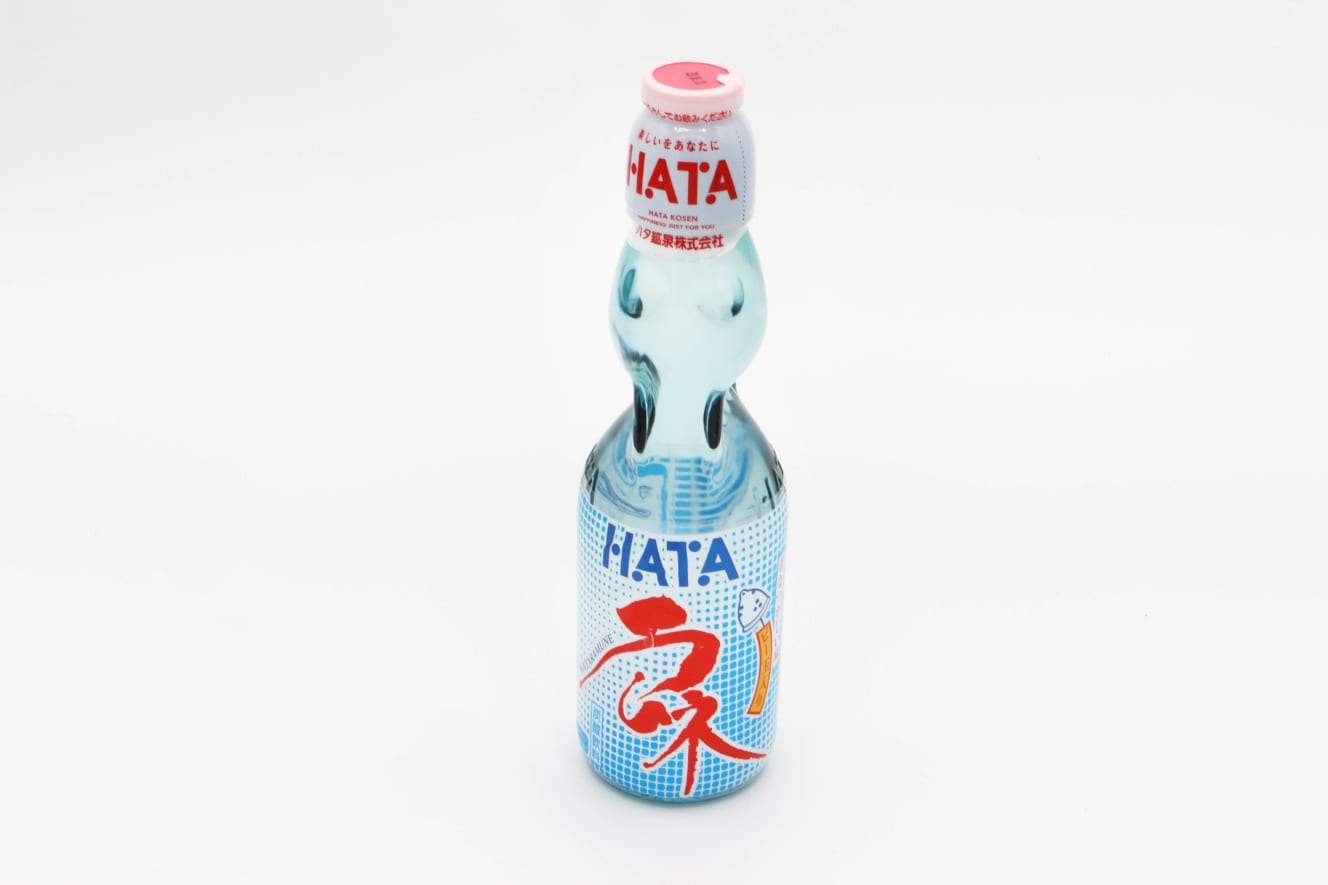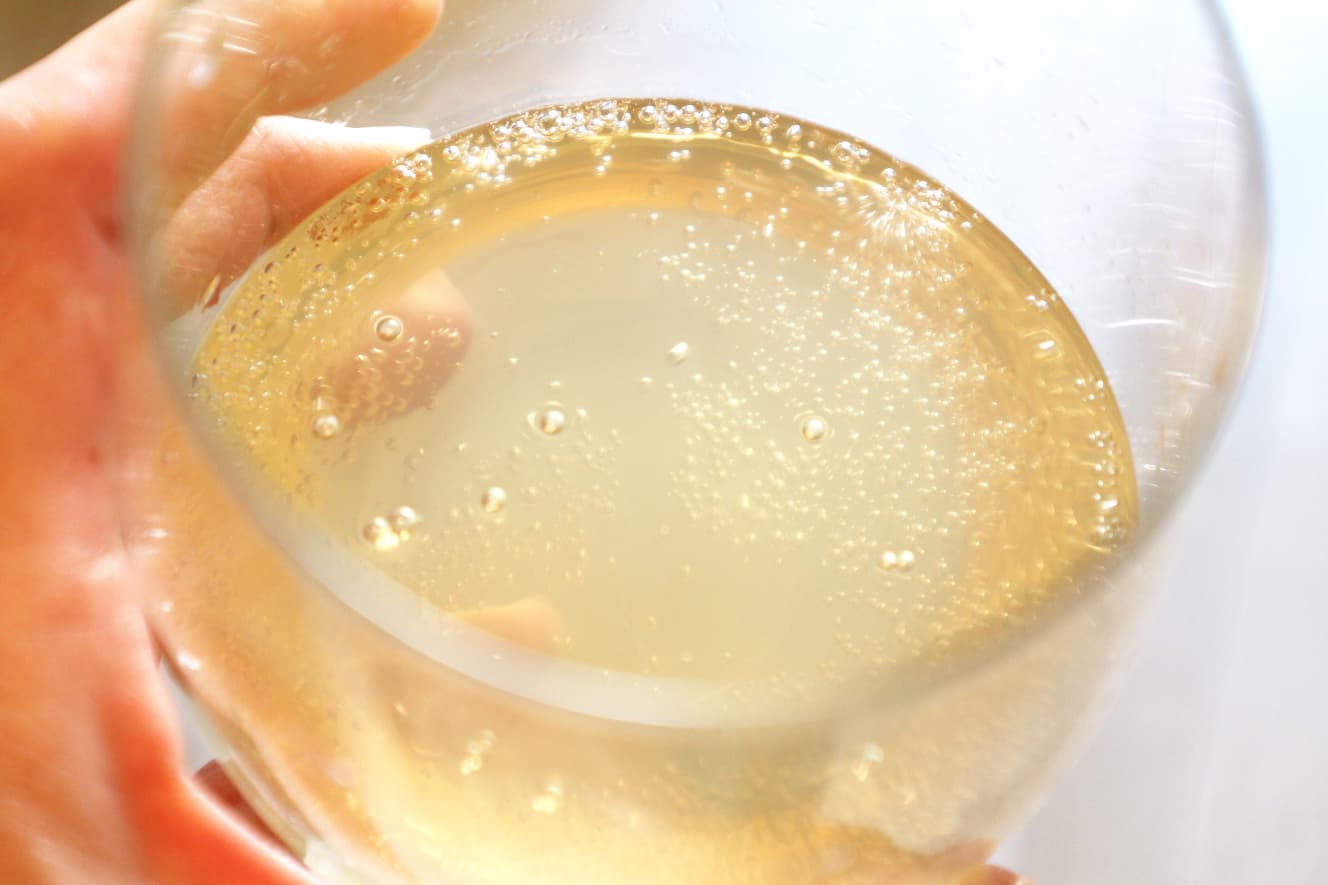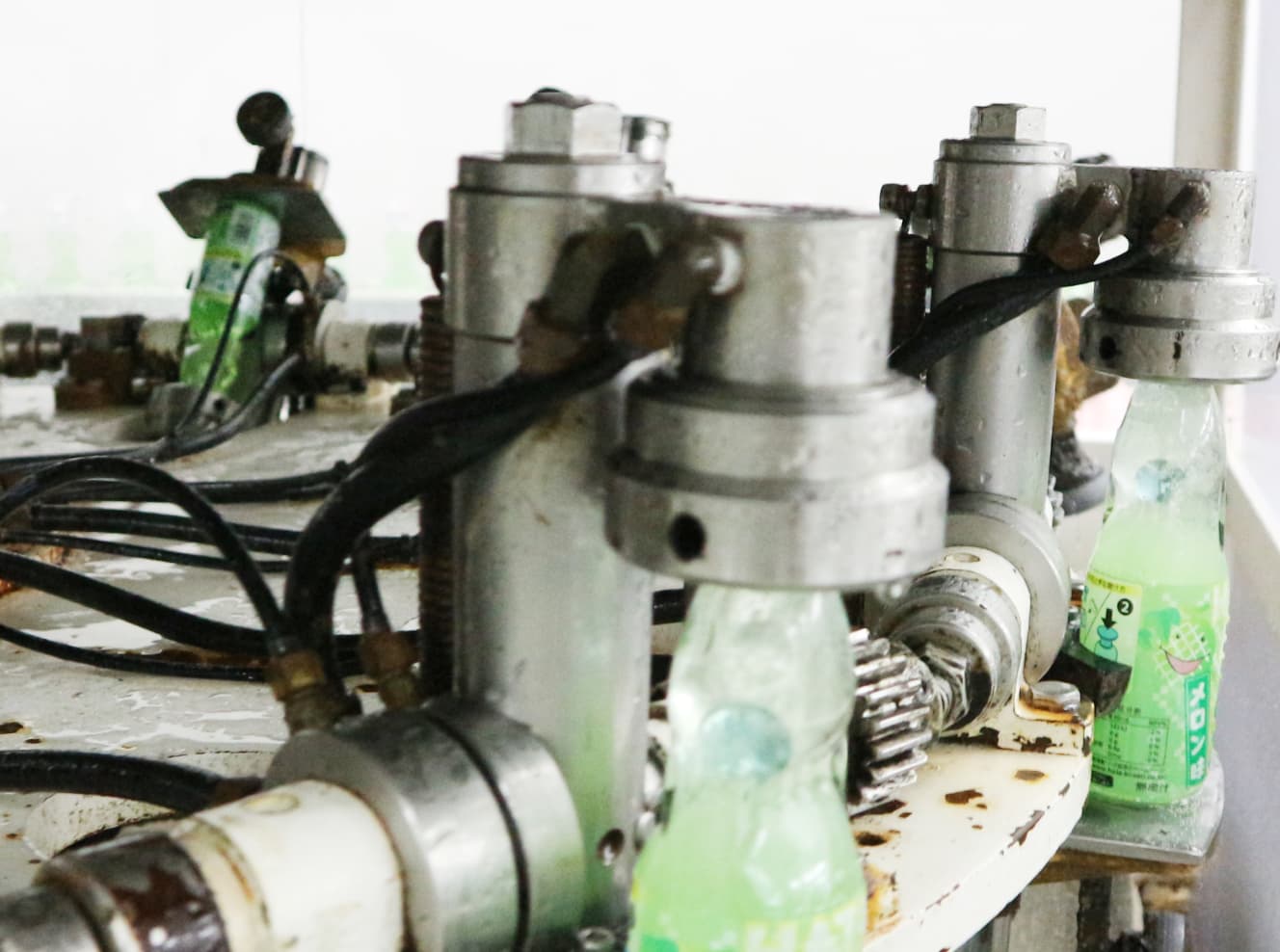Takoyaki-style, Kimchi-style… Why a company that makes a series of unusual ramune products is doing well!
With the declining birthrate and the Covid-19 disaster, the company is on a roll! An inside look at Osaka's Hata Kosen, which has the largest share of the Japanese ramune market
“Ramune” should not be made by major manufacturers!
You’ve probably had it at a food stand at a summer festival or after a bath at a public bath. You probably drank ramune, a carbonated drink with marbles in it, in the past. In fact, almost all the ramune in Japan is made at Hata Kosen in Miyakojima-ku, Osaka City. The name may sound old-fashioned, as if it has been around since just after the end of the war, but it was founded in 1946. The company has been making ramune for more than ten years now, and has become a hot topic of conversation with a series of unusual flavors such as “Takoyaki-style,” “Kimchi-style,” and “French fries-style.

At one time, rare ramune was quite popular in the media, but with the declining birthrate and no festival in Covid-19, I wondered if sales would be okay these days. But with the declining birthrate and the lack of a festival in Covid-19, I wondered if sales would be okay these days…” Nekota, feeling a little worried, decided to go to Hata Kosen. Then, he found out a surprising fact…
What did I learn about the amazing ramune situation when I visited Hata Kosen?



Mr. Hata is the second generation president. He was originally from Wakayama and joined his uncle’s ramune factory before setting up his own company here. At that time, there were about 2,000 companies making ramune in Japan! There were also about 170 companies in Osaka. I wonder if there was that much demand for ramune.
But now, there are only about 30 companies nationwide, and only about 4 in Osaka.

Actually, there is a law in Japan called the “Field Adjustment Law” to protect small and medium-sized companies, and only small and medium-sized companies are allowed to make six types of beverages, including ramune and polyethylene soft drinks (so-called “chew chew”).
And why do ramune have marbles to cover them? The marbles get in the way and make it hard to drink at the end! This shape was originally invented more than 100 years ago by a man named Codd in England, who said that marbles were the best type of stopper for sealing carbon dioxide gas under pressure.
This may not sound like much to you, so I will explain it later along with the manufacturing process.

Hata Kosen started out making regular ramune, but about 15 years ago, they started selling a lot of strange ramune, which became a hot topic. I asked the president about this.

- President: “How did you hear about this company?
- Nekota: “Actually, my house is in this neighborhood…. I just happened to be passing by.
- President: “You noticed it too late!
- Nekota: “It’s only been about a year and a half since I moved here… Nekota: “I’ve only moved here for about a year and a half… By the way, Mr. President, there are many flavors of ramune, why did you make this one?

President: “Well, I guess. It’s just for fun! I was just kidding, but since we were in Osaka, I thought we should try to create something that would taste like Osaka. The first one I made was takoyaki style. There’s no octopus in it. That’s why it was called “Fu. Also, the kimchi style is because Osaka has Tsuruhashi Korean Town. The corn potage style is an imitation of a certain ice cream!

- Nekota: “I knew it was just for fun (laughs)! What was the best-selling item?
- President: “Kimchi is popular. It’s a punishment game.
- Nekota: “Are you sure it’s a punishment, company-wise?
- Nekota: “Is it really a punishment game for the company?” The president: “Also, there was a dish called ‘Mizunasu’ style, which was made by adding the juice of real pickled eggplant. It was really good, but the cost was too high and the more we sold, the more we lost, so we stopped.

- Nekota: “Are there any flavors that were unpopular?”
- Nekota: “There was one flavor that was not well received. Also, dough. It had the flavor of Yodo River ditch. We thought that was a bad idea, so we put the brakes on it and stopped. Nekota: “It’s good to know there are decent people here! Oh, excuse me.”
- President: “Basically, big supermarkets say, ‘We can’t put this in the store. But some supermarkets, candy shops, and the Internet think it’s funny, so it’s selling well.

Hmmm. With the birthrate declining and the number of candy shops dwindling, the more I listened, the more I wondered how this company was able to sustain itself.
Hata Kosen’s ramune is exported to 45 countries overseas!

- President: “We have been working hard and gaining trust for a long time, developing new sales channels every year, and our domestic market share has grown to about 50 to 60%. Then, about 15 years ago, we started to develop overseas sales channels, saying, “Maybe we can do it overseas, too. About 15 years ago, we started to develop new sales channels, and the product has been selling surprisingly well.
- Nekota: “Wow, I wonder who drinks it.
- Nekota: “Who drinks it? It’s also sold in major supermarkets. Of course, it costs a lot of money to ship it over there, so a bottle that costs about 100 yen in Japan costs about 200 to 300 yen. It’s a luxury drink.
- Nekota: “I wonder why people drink so much ramune.
- President: “Well, there’s no such thing as a drink with marbles in it!
Nekota: “There are marbles in it! Let’s try it! President: “Well, there’s no such thing as a drink with marbles in it! It’s true that in a world full of carbonated drinks, it’s surprising to find a drink with such a pure taste of “carbonation, sugar, and more. In a world full of carbonated drinks, it may be surprising to find a drink with such a pure taste.

A tour of the factory in full operation, producing 200,000 bottles a day.

Next, we were given a tour of the factory to see how ramune is made. The main factory in Miyakojima produces about 200,000 bottles a day, and the second factory in Aichi produces about 300,000 bottles a day, including those for overseas markets. It’s amazing to see how much the people of the world demand Ramune.
At the factory, ramune is being mass-produced by automated machines. An employee who was used to showing us around the factory gave us an easy-to-understand explanation.
The manufacturing process is rather simple. A marble is placed in a bottle that has been cleaned and labeled, and syrup and carbonation are sealed in. By rotating the bottle immediately, the pressure of the carbonation causes the marble to be pressed against the mouth, forming a stopper. Whoever thought of this was very clever! It’s also shocking to know that the process has not changed in 100 years, even in the age of harmony.


In the past, bottles were collected, washed, and reused, but that was a hassle for the vendor and a hygiene problem, so they changed to the “one-way bottle” system, which does not require collection and is bottle style. Well, in the past, you used to get 20 yen or so when you went to return the bottle.
Consumption grew in Covid-19, that product!
By the way, Hata Kosen doesn’t only make ramune. Didn’t you often drink “Champagne” at Christmas? ”Chancery. It’s a champagne-like carbonated drink that flies up to the ceiling when you open the bottle and break the light bulb.

This is also a drink that is protected by the “Field Adjustment Law” and can only be made by small and medium-sized companies. It’s so deep… Also, the “yoi koko awaobi” that can be found in restaurants is a Hata Kosen original.
It is said that with the recent self-restraint on alcohol and drinking at home, the sales of chammeries and awabii have increased.
Indeed, Chancery is a so-called sweet non-alcoholic sparkling wine. It is sure to be a hit at Italian restaurants. Also, the bubbles produced by Awabii are just like those produced by beer. I’ll do it! I’ve heard that adults are delighted with it. In izakaya (Japanese style pubs), ramune is mixed with shochu to make a ramune high, and there are more and more opportunities for adults to drink it.

“We are getting more inquiries from the restaurant industry for adult beverages. “We are getting more inquiries from the restaurant industry for adults. When my grandchildren drink it, they wonder if they’ll be all right,” says the president with a smile on his face. His grandchildren must be so cute!
The third son in charge of sales was also a character like the president…

As a matter of fact, the president’s third son, Mr. Naohisa, who is in charge of sales, was also present that day. At first I had the impression that he was very serious, but…
- Nekota: “Mr. Naohisa, you are a certified sommelier, aren’t you? Can you make use of it in product development?”
- Naohisa: “I haven’t been able to use it at all!
- President: “I specialize in drinking. I’m the banquet manager. This girl came to our company the year before last. I didn’t know she was coming to our company at all!
- Naohisa: “I told her! Takahisa: “I told her! I’m looking forward to working with her next year.
- President: “I don’t remember what we talked about at the bar.
I almost forgot about the interview because I felt like I was going on and on with my rambling, but then I came to my senses and asked, “Are you thinking about the next flavor? I asked, “Are you thinking about the next flavor? When I suggested the idea of a ramen flavor, he replied, “No, no, no, there are too many flavors! We need to make pork bone, salt, Kurume flavor, Kitakata flavor, rich and light, and many others.
No one is asking for that level of subdivision… (laughs)! Hata Kosen is not only passionate about making ramune, but also has a playful spirit of making interesting things thoroughly, as is expected of a company from Osaka.
After this, I kept asking, “Where is Nekota-san’s house? “Around the back of Don Quijote” (Nekota) “Oh! (Mr. Naohisa) “Near the love hotel district” (Mr. President) “How did you know that?
You can buy ramune and other products at the Hata Kosen website. My friend said, “This ramune is good for hangovers! my friend said. I don’t know if that’s the right way to use it, but you might want to go back to your childhood and try it.
Interview, text, and photo: Shigeru Nekota
Born in 1979. Worked as an editor and writer for town magazines, travel books, and recipe books. Currently writes as a web writer on a wide range of topics from decadence to traditional crafts. Despite his weakness, he loves to drink, and his life's motto is "drinking while walking is the best way to enjoy sake.
Shigeru Nekoda's Food Blog
Shigeru Nekoda's food blog "I love peculiar restaurants! http://nekotashigeru.site/

